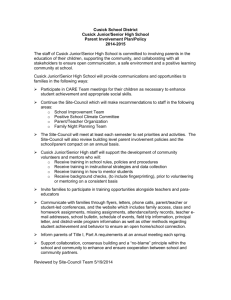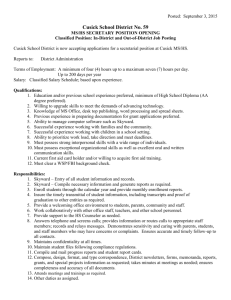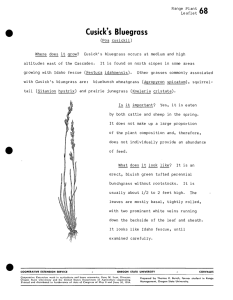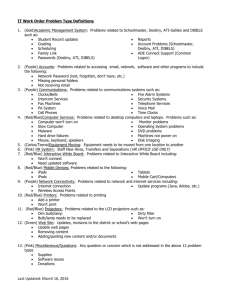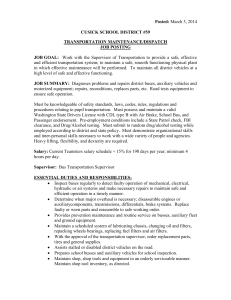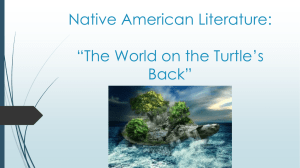Document 25218796
advertisement
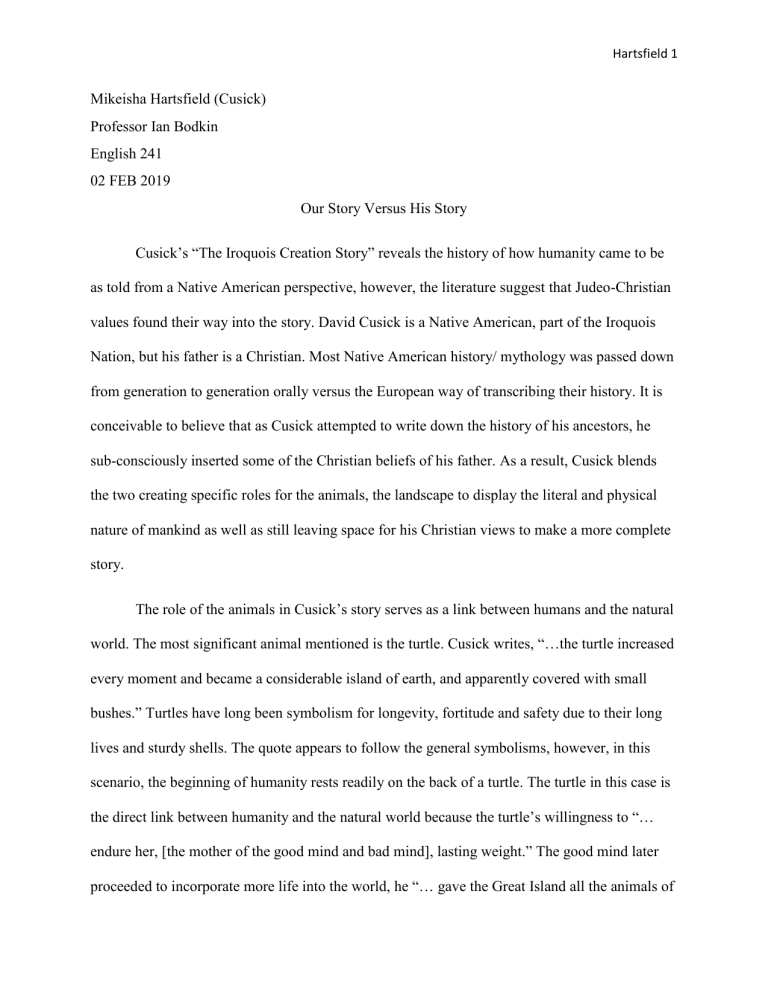
Hartsfield 1 Mikeisha Hartsfield (Cusick) Professor Ian Bodkin English 241 02 FEB 2019 Our Story Versus His Story Cusick’s “The Iroquois Creation Story” reveals the history of how humanity came to be as told from a Native American perspective, however, the literature suggest that Judeo-Christian values found their way into the story. David Cusick is a Native American, part of the Iroquois Nation, but his father is a Christian. Most Native American history/ mythology was passed down from generation to generation orally versus the European way of transcribing their history. It is conceivable to believe that as Cusick attempted to write down the history of his ancestors, he sub-consciously inserted some of the Christian beliefs of his father. As a result, Cusick blends the two creating specific roles for the animals, the landscape to display the literal and physical nature of mankind as well as still leaving space for his Christian views to make a more complete story. The role of the animals in Cusick’s story serves as a link between humans and the natural world. The most significant animal mentioned is the turtle. Cusick writes, “…the turtle increased every moment and became a considerable island of earth, and apparently covered with small bushes.” Turtles have long been symbolism for longevity, fortitude and safety due to their long lives and sturdy shells. The quote appears to follow the general symbolisms, however, in this scenario, the beginning of humanity rests readily on the back of a turtle. The turtle in this case is the direct link between humanity and the natural world because the turtle’s willingness to “… endure her, [the mother of the good mind and bad mind], lasting weight.” The good mind later proceeded to incorporate more life into the world, he “… gave the Great Island all the animals of Hartsfield 2 game for their maintenance.” Cusick is expressing the belief that the animals of this world were left in the care of the Great Island which is the turtle. In this case, one could argue that the turtle is indeed the link between man and animal as it was the backs of the turtle that allowed the good and bad mind to be conceived and bring about humans and is also the land in which animals live and inhabit. Humans and animals are linked directly by the landscapes that they both share for their food, shelter, water and general livelihood. The story reads, “… he [the good mind] formed numerous creeks and rivers on the Great Island, and then created forests, and fishes of all kind to inhabit the waters.” Later, Cusick writes, “the bad mind, while his brother was making the universe, went throughout the Island and mad numerous high mountains and falls of water, and great steeps and also various reptiles which would be injurious to mankind…” In both scenarios, the landscape plays a role in the interaction between man, animals and the environment. The good mind created favorable landscapes for mankind to live and enjoy along with the animals while the bad mind created dangerous landscapes to challenge man and animals alike. It is the landscape that is the final link between man, animals and the natural world. The human characters, the good mind and bad mind, appear to represent a triple entendre of things; the good and bad nature of man, the good and bad nature of animals and the good and bad nature of the landscape. It is the human characters that are orchestrating all these different things, however, there is a constant interaction that continues to negate the force of good and bad. Together, Cusick appears to use them to balance what he and his Iroquois ancestors believe about the natural world. The story reads, “…one of the infants in her womb was moved by an evil opinion and he was determined to pass out under the side of the parent’s arm, and the other infant in vain endeavored to prevent his design.” The good and bad mind are the origination of Hartsfield 3 nature in the spirit form, but they also seek to balance on another like light and darkness. Cusick presents them as humans but they behave more in line with spirits than humans because of their one-sided natures. Cusick is telling a “history” of the creation of mankind as told by the Iroquois Native Americans, however, Christianity is arguably a deep influencer of the way the story is expressed and depicted. Cusick asserts, “…he [the good mind] formed two images of dust of the ground in his own likeness, male and female, and by breathing into their nostrils he gave them the living souls…” Genesis chapter two verse seven reads, “ … then God formed man of the dust from the ground and breathed into his nostrils and breath of life, and the man became a living creature.” It is evident that Cusick is subconsciously or perhaps intentionally combining the two narratives of the creation of man. The logical explanation of this is that Cusick is trying to blend the reality of him being Christian with the fact that he is also a Native American. The two have many things in common and the view of creation of life would be easy enough to blend. The inclusion of the Christian beliefs is potentially troublesome because it could lead on to question the authenticity of the story or the original telling of the story. The animals, landscape and the “human characters” are an attempt to “Native Americanize” the creation of mankind. It I the mid 1800’s when Cusick writes “The Iroquois Creation Story” which is significant because colonists have long since been in America and the Natives are struggling to preserve their lands, their history/culture and their livelihood. American literature is already circulating the colonies and the Natives have no persistent method of transcribing their history or existence and as they integrate with the colonies, they risk losing all their history. Simply put, one could argue that the Natives were losing the war on words and Cusick made a last-ditch attempt to save some elements of Iroquois history even if it meant that Hartsfield 4 he would blend Christian values into the narrative. This would then indicate that the narrative itself is as much about the creation of mankind as it is about the Natives having some semblance of their beliefs and history in written form. In a sense, the Iroquois are one generation away from losing this story forever had Cusick not taken the time to write it. Cusick’s story has multiple elements that one should consider to fully understand and appreciate his work. The animals in his story are of great significance because it is the traditional Native American way to describe or interpret the world around them through the usage of animals as symbolism. It is also important to understand the landscape because it is what provides homes for all of mankind and animals in the story and Cusick makes sure to emphasize the creation of the Great Island as a key event in the development of man. The human characters is where the story Christian values take the stage are a clear as the behavior of the good mind and bad mind resembles the great fight between the devil and God in the fall of Lucifer. However, while those things are major elements to the story, it is the work itself that is more important than all the literal relevance. The development of the narrative itself is short, not necessarily as precise and detailed of an account like the story of the creation of Adam and Eve. Cusick’s story was not merely about creation, it was about preservation of parts of his history as well as the adoption of new-found values because of colonialism. Hartsfield 5 Works Cited Cusick, David. "The Iroquois Creation Story." The Norton Anthology of American Literature. Ed. Nina Baym and Robert Levine. Vol. I. New York: W.W. Norton and Company, 2013. 20-23. Print. ESV Study Bible: English Standard Version. Crossway Bibles, 2016.
